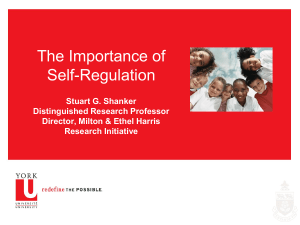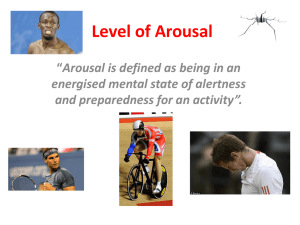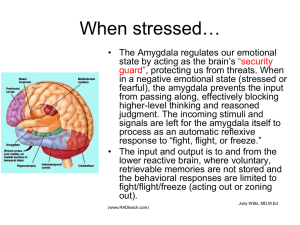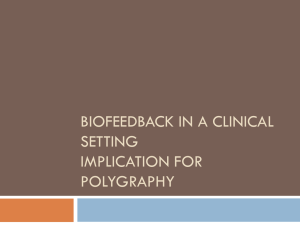Step Up To: Psychology
advertisement
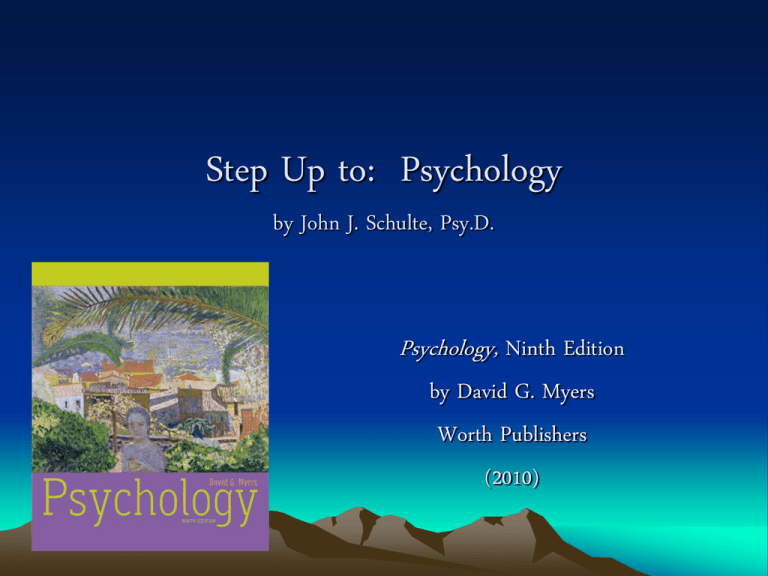
Step Up to: Psychology by John J. Schulte, Psy.D. Psychology, Ninth Edition by David G. Myers Worth Publishers (2010) Chapter 12: Emotions, Stress, and Health Show Your Feelings Let’s Get Physical What a Rush! Stressed Out? What Can I Do? What a Rush! 500 400 300 200 100 Let’s Get Physical 500 400 300 200 100 Show Your Feelings 500 400 300 200 100 Stressed Out? 500 400 300 200 100 What Can I Do? 500 400 300 200 100 1. The belief that emotions are experienced following physical responses is the: • • • • A) the two-factor theory. B) the Cannon-Bard theory. C) the James-Lange theory. D) self-efficacy theory. 2. The idea that an emotion-arousing stimulus simultaneously triggers physiological response and the subjective experience of emotion is: • • • • A) the James-Lange theory. B) the Cannon-Bard theory. C) the two-factor theory. D) the three-factor theory. 3. The two-factor theory of emotion differs from the James-Lange and the Cannon-Bard in that: • A) physiological arousal is not always necessary. • B) emotional experience precedes physiological arousal. • C) physiological arousal and emotional experience occur simultaneously. • D) a cognitive label precedes emotional experience. 4. When aroused, your heart rate increases, your pupils dilate, and you may sweat, indicating activation of the part of your nervous system called: • A) the amygdala. • B) the sympathetic nervous system. • C) the parasympathetic nervous system. • D) the peripheral nervous system. 5. A professional tennis player will usually perform better when: • • • • A) arousal is high. B) arousal is low. C) competition is easy. D) he/she is more relaxed. 6. A polygraph is an instrument that detects: • • • • A) lying. B) guilt and lies. C) physical responses. D) truth. 7. Polygraph exams are not used to determine guilt or innocence in court because: • • • • A) they are too expensive. B) people do not give consent. C) polygraphs are fakery. D) 1/3 of innocent people are found guilty. 8. The expression, “Arousal fuels emotion, cognition channels it,” is a summation of: • A) the Schachter and Singer experiment. • B) the Cannon-Bard theory. • C) the James-Lange theory. • D) how polygraphs work. 9. When you are faced with a threatening stimulus, there is a “shortcut” neural pathway to allow a speedy emotional response, and it runs from the: • • • • A) hypothalamus to the amygdala. B) amygdala to the cerebral cortex. C) hypothalamus to the medulla. D) thalamus to the amygdala. 10. The amygdala sends more neural impulses to the cerebral cortex than it receives, resulting in: • A) emotions occurring before thoughts. • B) our feelings more easily ruling our thoughts. • C) some people becoming very anxious. • D) confusion about what we are feeling. 11. People abused as children are more prone to interpret expressions in others as anger, giving evidence that: • A) abuse leads to heightened anger. • B) abuse results in fearful people. • C) prior experience can sensitize us to certain emotions. • D) early childhood experiences cripple us for life. 12. Emotionally, women surpass men in their ability to: • A) read people’s emotional cues. • B) spot lying. • C) tell whether two people are really in love. • D) all of the above. 13. The ____ is more effective than a polygraph machine: • • • • A) guilty knowledge test B) larcenous reaction test C) standard neuro-scan D) innocence scale 14. When traveling around the world, facial expressions: • • • • A) differ with each culture. B) are universal across cultures. C) are similar among races. D) differ when comparing Western with Eastern cultures. 15. When Steven held a pen in his teeth, the comic strip seemed funnier to him. This is explained by the: • • • • A) grin and bear it theory. B) facial drift theory. C) behavior feedback phenomenon. D) acting “as if” phenomenon. 16. Whether we experience stress depends upon: • • • • A) the situation. B) how life threatening it is. C) our cognitive appraisal. D) whether others are involved. 17. The two-track stress response system involves the cerebral cortex and the _____. • • • • A) sympathetic nervous system B) peripheral nervous system C) heart and lungs D) corpus collosum 18. According to Selye’s general adaptation syndrome, we are most likely to become ill as the result of stress during the ___ phase. • • • • A) alarm B) resistance C) exhaustion D) recovery 19. Stress is related to the leading cause of death in the U.S., which is: • • • • A) cancer. B) coronary heart disease. C) suicide. D) stroke. 20. Research suggests that those with Type A personality could reduce their risk of heart disease if they would: • A) drink more alcohol. • B) sleep more. • C) let their anger out on a punching bag. • D) let go of their anger. 21. Being a pessimist: • A) can increase your level of stress. • B) can shorten your life. • C) can raise your blood pressure. • D) all of the above. 22. Mary has been suffering from the “blues.” Your recommendation is that she first try: • • • • A) electric shock. B) aerobic exercise. C) Prozac. D) psychoanalysis. 23. With regard to the effectiveness of biofeedback: • A) biofeedback is the most effective method for alleviating stress-related illnesses. • B) biofeedback is as effective as relaxation. • C) biofeedback is ineffective for alleviating stress. • D) biofeedback is a modern snake oil and only works because of a placebo effect. 24. When alternative medicine approaches, such as acupuncture, are scientifically tested, the results: • • • • A) are never as good as they promise. B) can be quite convincing. C) are explained as placebo effects. D) cannot be replicated in the laboratory. 25. Regular religious attendance is a positive predictor of a longer life span. Researchers have identified three factors that explain this, including all of the following, except: • • • • A) healthier life styles. B) social support networks. C) relaxed meditative style. D) faith healing. Stop here, or continue as a review 1. The belief that emotions are experienced following physical responses is the: • • • • A) the two-factor theory. B) the Cannon-Bard theory. C) the James-Lange theory. D) self-efficacy theory. 2. The idea that an emotion-arousing stimulus simultaneously triggers physiological response and the subjective experience of emotion is: • • • • A) the James-Lange theory. B) the Cannon-Bard theory. C) the two-factor theory. D) the three-factor theory. 3. The two-factor theory of emotion differs from the James-Lange and the Cannon-Bard in that: • A) physiological arousal is not always necessary. • B) emotional experience precedes physiological arousal. • C) physiological arousal and emotional experience occur simultaneously. • D) a cognitive label precedes emotional experience. 4. When aroused, your heart rate increases, your pupils dilate, and you may sweat, indicating activation of the part of your nervous system called: • A) the amygdala. • B) the sympathetic nervous system. • C) the parasympathetic nervous system. • D) the peripheral nervous system. 5. A professional tennis player will usually perform better when: • • • • A) arousal is high. B) arousal is low. C) competition is easy. D) he/she is more relaxed. 6. A polygraph is an instrument that detects: • • • • A) lying. B) guilt and lies. C) physical responses. D) truth. 7. Polygraph exams are not used to determine guilt or innocence in court because: • • • • A) they are too expensive. B) people do not give consent. C) polygraphs are fakery. D) 1/3 of innocent people are found guilty. 8. The expression, “Arousal fuels emotion, cognition channels it,” is a summation of: • A) the Schachter and Singer experiment. • B) the Cannon-Bard theory. • C) the James-Lange theory. • D) how polygraphs work. 9. When you are faced with a threatening stimulus, there is a “shortcut” neural pathway to allow a speedy emotional response, and it runs from the: • • • • A) hypothalamus to the amygdala. B) amygdala to the cerebral cortex. C) hypothalamus to the medulla. D) thalamus to the amygdala. 10. The amygdala sends more neural impulses to the cerebral cortex than it receives, resulting in: • A) emotions occurring before thoughts. • B) our feelings more easily ruling our thoughts. • C) some people becoming very anxious. • D) confusion about what we are feeling. 11. People abused as children are more prone to interpret expressions in others as anger, giving evidence that: • A) abuse leads to heightened anger. • B) abuse results in fearful people. • C) prior experience can sensitize us to certain emotions. • D) early childhood experiences cripple us for life. 12. Emotionally, women surpass men in their ability to: • A) read people’s emotional cues. • B) spot lying. • C) tell whether two people are really in love. • D) all of the above. 13. The ____ is more effective than a polygraph machine: • • • • A) guilty knowledge test B) larcenous reaction test C) standard neuro-scan D) innocence scale 14. When traveling around the world, facial expressions: • • • • A) differ with each culture. B) are universal across cultures. C) are similar among races. D) differ when comparing Western with Eastern cultures. 15. When Steven held a pen in his teeth, the comic strip seemed funnier to him. This is explained by the: • • • • A) grin and bear it theory. B) facial drift theory. C) behavior feedback phenomenon. D) acting “as if” phenomenon. 16. Whether we experience stress depends upon: • • • • A) the situation. B) how life threatening it is. C) our cognitive appraisal. D) whether others are involved. 17. The two-track stress response system involves the cerebral cortex and the _____. • • • • A) sympathetic nervous system B) peripheral nervous system C) heart and lungs D) corpus collosum 18. According to Selye’s general adaptation syndrome, we are most likely to become ill as the result of stress during the ___ phase. • • • • A) alarm B) resistance C) exhaustion D) recovery 19. Stress is related to the leading cause of death in the U.S., which is: • • • • A) cancer. B) coronary heart disease. C) suicide. D) stroke. 20. Research suggests that those with Type A personality could reduce their risk of heart disease if they would: • A) drink more alcohol. • B) sleep more. • C) let their anger out on a punching bag. • D) let go of their anger. 21. Being a pessimist: • A) can increase your level of stress. • B) can shorten your life. • C) can raise your blood pressure. • D) all of the above. 22. Mary has been suffering from the “blues.” Your recommendation is that she first try: • • • • A) electric shock. B) aerobic exercise. C) Prozac. D) psychoanalysis. 23. With regard to the effectiveness of biofeedback: • A) biofeedback is the most effective method for alleviating stress-related illnesses. • B) biofeedback is as effective as relaxation. • C) biofeedback is ineffective for alleviating stress. • D) biofeedback is a modern snake oil and only works because of a placebo effect. 24. When alternative medicine approaches, such as acupuncture, are scientifically tested, results: • • • • A) are never as good as they promise. B) can be quite convincing. C) are explained as placebo effects. D) cannot be replicated in the laboratory. 25. Regular religious attendance is a positive predictor of a longer life span. Researchers have identified three factors that explain this, including all of the following, except: • • • • A) healthier life styles. B) social support networks. C) relaxed meditative style. D) faith healing. Acknowledgments • Step Up Created by: – John J. Schulte, Psy.D. • Based on Psychology, Ninth Edition by David G. Myers • Published by Worth Publishers (2010) Answers 1. C 9. D 17. A 2. B 10. B 18. C 3. D 11. C 19. B 4. B 12. D 20. D 5. A 13. A 21. D 6. C 14. B 22. B 7. D 15. C 23. B 8. A 16. C 24. C 25. D

